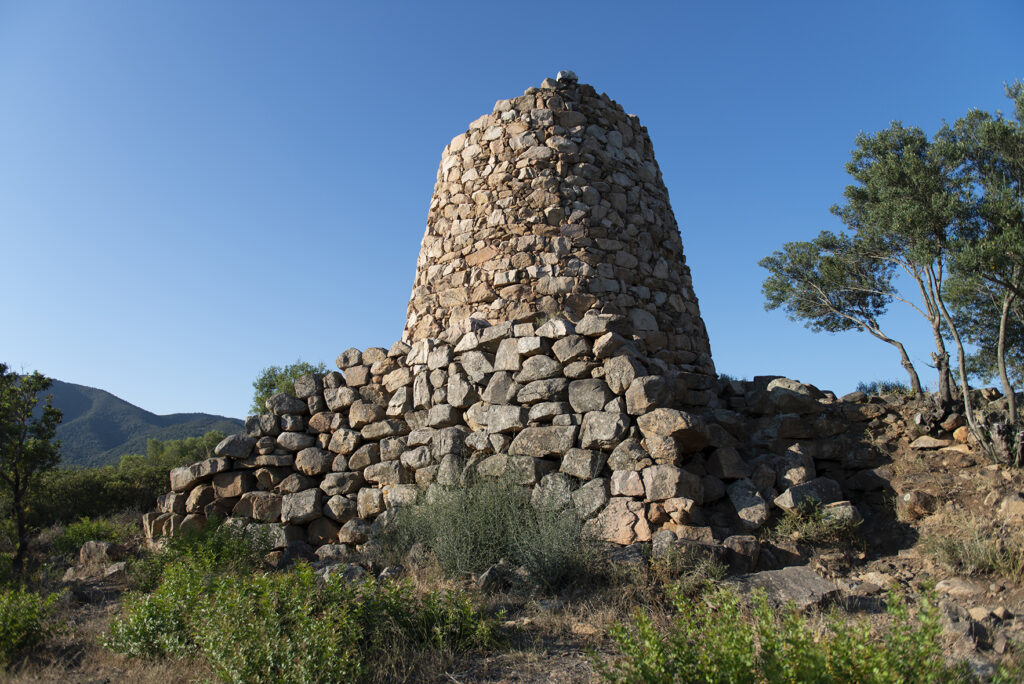
Nuraghe de s’Òru

La valle del Rio Picocca è ricca di testimonianze di ogni epoca, in particolare quella nuragica. Il nuraghe s’Òru noto anche Asòru, Basòru o de is Órus, è stato realizzato in conci di granito ed è costituito da un alto bastione di forma subtriangolare che ingloba la torre centrale e il cortile. L’accesso alla struttura è orientato a sud, l’ingresso architravato conduce al cortile interno da cui è possibile, prendendo la breve scala sulla destra, salire sul bastione, oppure accedere alla torre principale. Della torre centrale, alta 13 metri, rimane solamente il paramento esterno. Nei lati ovest e nord del bastione si aprono due pozzi verticali che fanno presumere la presenza di camere afferenti a torri secondarie oggi non più presenti. Va rilevato, infatti, che il monumento è stato soggetto ad attività di spoglio, in particolare sul lato sud, per ricavare conci necessari alla costruzione nella seconda metà dell’Ottocento dei ponti della SS 125 sui torrenti Su Linnàmini e Cugurranti. Il nome del nuraghe deriva da una leggenda che parla di una coppia che, intenta a cercare asparagi, trovò nel letto del torrente Su Linnàmini – S’Arridelaxu delle monete.

Nuraxi de s’Òru Sa pranaxa de s’Arriu de sa Picoca est arrica de testimonias de dònnia edadi, pruschetotu cussa nuraxesa. Su nuraxi de s’Òru connotu puru cumenti Asòru, Basòru o de is Órus, est stètiu pesau cun contonis de granitu e est costituiu dae unu bastioni artu de forma subtriangulari chi incorporat sa turri centrali e sa pratza. S’imbucada de su fàbbricu est facias a sud, su cantarxali de imbucada portat a sa pratza dae innui est possìbbili, pighendi sa scaleredda a sa dereta, artziai a su bastioni, opuru imbucai a sa turri principali. De sa turri centrali, arta 13 metrus, abarrat sceti su paramentu de foras. In is alas ovest e nord de su bastioni s’abrexint duus putzus verticalis chi faint pentzai a sa presèntzia de aposentus pertocantis a is turris segundàrias oindii sparèssias. Tocat a tenni in contu, difatis, ca su monumentu est stètiu sculau, pruschetotu in sa parti de ananti, po ndi bogai is contonis chi serbiant a sa costrutzioni in sa segunda metadi de s’Otuxentus de is pontis de sa SS 125 in is arrius de su Linnàmini e de Cugurranti. Su nòmini de su nuraxi benit dae una paristòria chi contat de una còpia chi, circhendi sparau, at agatau in su letu de s’arriu de su Linnàmini – s’Arridelaxu unus cantu soddus.

Nuraghe of s’ÒruThe Rio Picocca valley is rich in testimonies from every era, in particular the Nuragic one. The s’Òru nuraghe also known as Asòru, Basòru or de is Órus, was built in granite ashlars and consists of a high subtriangular bastion which incorporates the central tower and the courtyard. Access to the structure is oriented to the south, the architraved entrance leads to the internal courtyard from which it is possible, by taking the short staircase on the right, to climb the bastion, or access the main tower. Of the central tower, 13 meters high, only the external facing remains. On the west and north sides of the bastion there are two vertical wells which suggest the presence of chambers relating to secondary towers no longer present today. It should be noted, in fact, that the monument was subjected to stripping activities, particularly on the south side, to obtain ashlars necessary for the construction of the SS 125 bridges over the Su Linnàmini and Cugurranti streams in the second half of the nineteenth century. The name of the nuraghe derives from a legend that speaks of a couple who, intent on looking for asparagus, found some coins in the bed of the Su Linnàmini – S’Arridelaxu stream.

Bibliografia:
Ledda R., Censimento archeologico nel territorio del comune di Villaputzu. Muros, Edizioni Castello, 1989.
Archivio Archeo Sarrabus, Limen Sarrabus Gerrei APS